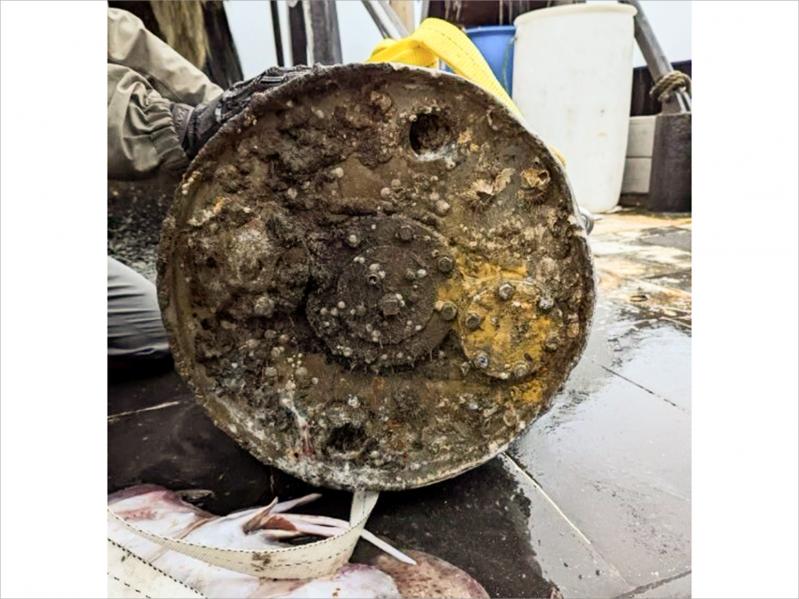Talk about the deadliest catch: A Rhode Island-based trawler fishing off Block Island on Oct. 25 hauled in an unexploded World War II-era depth charge that was later safely detonated by the United States Navy.
The Ocean State, owned and operated by Glenn Wescott of Narragansett, was fishing about four nautical miles east of Block Island when his crew noticed a peculiar, cylindrical-shape object in the net, along with a mess of scup, fluke, and skate.
The crew did some quick research online and soon determined the object was a depth charge.
Captain Wescott reported the bomb in his net to the U.S. Coast Guard station at Point Judith, and a Coast Guard detachment arrived quickly. The captain and two crew members, his son and his nephew, were taken off the trawler and to safety.
The Coast Guard’s U.S.S. Hammerhead then enforced a one-mile overnight restricted zone around the Ocean State, said Boston-based Petty Officer Ryan Noel. The next morning, a special detail from the Newport, R.I., naval base arrived.
A spokesman at the Navy’s Mid-Atlantic Region headquarters in Norfolk, Va., told The Star this week that the unexploded depth charge was still in the Ocean State’s net when the Explosive Ordnance Disposal team got there. A Navy Explosive Ordnance Mobile Unit determined that it was a “520-pound MK-6 depth charge containing 267 pounds of TNT.”
The Navy spokesman noted in an email that the area the Ocean State was dragging was near the site of one of the last naval battles of the war, when the German U-Boat U-853 was sunk by the U.S.S. Atherton, a Navy destroyer, and the Coast Guard frigate U.S.S. Moberly, on May 6, 1945.
Germany surrendered two days later, ending the war in Europe.
In all, the email said, 195 depth charges were dropped during the battle with U-853, along with more than 200 “hedgehog bombs,” which explode on impact.
One of the depth charges deployed was apparently a dud — a dangerous dud.
U-853 was sent to the depths just days after it had sunk the Boston-based coal carrier Black Point during the Battle of Point Judith, the Navy said. The U-boat was also responsible for sinking at least two other American ships in the weeks before it went to the bottom of the Atlantic, along with its crew of 55.
The historically significant site where the German submarine rests — about seven nautical miles east of Block Island in 120 feet of water — is now a popular attraction for East End deep-sea divers.
Sea Turtle Dive Charters, based in Montauk, describes the wreck as “a must-see for enterprising deep divers. Though the sub is upright and intact, recent years have begun to show some breaking down of the 252-foot-vessel, but it remains one of the best U-boat dives anywhere in the world.”
Captain Wescott could not be reached for comment; an online maritime-tracking site reported that he was back on the water as of Nov. 1. He did first tell a Rhode Island TV news station, though, that he’d been fishing off Block Island for years, but dragging up a bomb was a first.
Other Rhode Island commercial fishermen told local media that they’d towed up body parts and military helmets from the same area over the years.
“We saw it going down the net, and they were suspicious of something,” Captain Wescott told NBC-10 TV, “so we checked everything out with photos, and sure enough, it was a depth charge.”
He also told The Providence-Journal, a newspaper, that he “didn’t understand why it happened now. I’ve towed through there so much. I don’t know why we got it. It’s a game of inches.”
The discovery gave rise to some online social-media speculation that the depth charge was torn free from its sandy grave by a survey ship from South Fork Wind, the offshore wind project jointly developed by Orsted and Eversource now working off the beach in Wainscott.
One wind-farm critic asked on Facebook: “What changed? On the same tow he has been making his entire life? A few days prior, windmill boats were moving boulders nearby. Doing ‘seabed preparation’ for a wind farm. Then, magically, a shiny metal (no marine growth except on the edges, which means it was previously buried) depth charge appears in the net and on deck? You do the math.”
A spokeswoman for South Fork Wind said they had done the math, and that the speculation was errant.
“There is no link between the UXO [unexploded ordnance] incident and any offshore wind-related work,” said a South Fork Wind spokeswoman, Meaghan Wims, via email.
“Our summer surveys covered different areas, and the seabed preparation work now underway for our South Fork Wind project is within the narrow confines of that wind farm’s submarine cable route,” she wrote, “in an area over 10 nautical miles away from the incident near Block Island.”
Ms. Wims added that offshore wind projects require substantial seafloor surveying, and that as part of that process, “our teams identified multiple unexploded ordnances in Rhode Island waters over the summer months as part of survey work for our Revolution Wind project, and outside of state waters as part of Sunrise Wind survey work. Since these surveys took place near historical defense sites, the finding of these confirmed UXOs wasn’t unusual. Many UXOs are charted on navigational charts in this region and have been for decades.”
If anything, South Fork Wind may have performed a public service by also identifying previously uncharted bombs on the seafloor, which Ms. Wims said “provided valuable new data for area mariners and increases safety for all who operate on the ocean.”
South Fork Wind has notified the Coast Guard and National Oceanic and Atmospheric Administration of those finds, “so that these ordnances could be appropriately charted, and we include the UXO locations in our regular mariner briefings.”
After securing the unexploded ordnance, the Navy bomb disposal specialists strapped an explosive charge to the bomb and blew it up on Oct. 26, about a mile offshore, while the Coast Guard maintained its perimeter around the detonation site. The Virginia-based Navy spokesman further noted in his email that the detonation was done in coordination with the State of Rhode Island Department of Environmental Management and the National Oceanic and Atmospheric Administration.
“The safety of people and the environment are our top priority in these situations,” the spokesman said.
Correction: This story has been updated since it was first published to correct the date that the ordnance was dragged up off Block Island.




